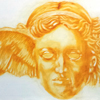Thelema Now Podcast Interview
Thelema Now Podcast Interview
Podcast interview with Harper Feist for Thelema Now
93 and welcome to 2021! Yay! And not a minute too soon.
To kick off the year right, TN’s own Harper Feist spoke to Roger Williamson, who also a Minnesota resident (by way of England). Roger is a visual artist as well as a writer, and in 2020 he re-released his book “The Sun At Night.”
Biography
Roger Williamson is a visual artist, residing and creating in Minneapolis Minnesota.
Born in Loughborough, England, in 1947 and growing up in Coventry he was inspired from an early age by the French Symbolist painters of late nineteenth century France,
These artistic influences, in conjunction with his own esoteric upbringing and practical experiences of magick, mythology and dream control, form the matrix, a collective oeuvre upon which his paintings and writings are an extension.
Roger Williamson’s works belong to a “theatre” of life. Building upon classical myths and ancient themes the paintings invite the viewers into spheres of consciousness- characterised by ethereal portraits and kaleidoscopic color palettes.
Williamson’s practice seeks to re-enliven a kind of mystery, revitalising the senses and questioning reality.
Using diverse creative media, whether painting or writing books, Williamson endeavors to develop techniques that materialize the sensuous dreaming experience into the language of the waking world.
Aspiring to reintroduce mystery and ambiguity back into the adventure of human existence through the creative process, encouraging artistic audiences towards “living effulgent and invigorating lives, revitalized from the secretions of our subconscious.”
Roger Williamson is the creator of Tarot of the Morning Star deck and the author of The Sun at Night.
Statement
Art is an externalization of struggle to rationalize and give form to something not understood.
The artist, like the oyster, is driven to externalize this conflict into the image of a pearl.
I believe art should be appreciated through a viewer’s individual intercourse with the work, allowing the image to speak for itself and not be prejudged by society’s academic paradigms.
This concept has close parallels to techniques first acquired in childhood, such as the ability to stare at clouds and see recognizable images arise and fall in the mind’s eye out of what initially was perceived as chaos.
Through this technique, letting a work speak to a deeper self than the superficial mind involves the viewer in the creative process, their imagination evolves the artwork to another level. The work is no longer stationary but part of a wave as is nature herself.

